How stones are formed in gallbladder. Gallstones: Causes, Symptoms, and Natural Remedies Explained
How are gallstones formed in the gallbladder. What are the main causes of gallstone formation. Can gallstones be treated naturally through gallbladder cleansing. What are the symptoms and risk factors associated with gallstones. How are gallstones diagnosed and treated medically.
Understanding Gallstones: Formation and Composition
Gallstones are crystal-like deposits that develop in the gallbladder, a small, pear-shaped organ responsible for storing bile. These deposits can vary significantly in size, ranging from as small as a grain of sand to as large as a golf ball. Their texture may be hard or soft, and their surface smooth or jagged. An individual may have a single gallstone or multiple stones.
The composition of gallstones can be categorized into two main types:
- Cholesterol stones: Accounting for about 80% of all gallstones, these are primarily made of hardened cholesterol.
- Pigment stones: Making up the remaining 20%, these stones consist of calcium mixed with bilirubin, a bile pigment.
The Process of Gallstone Formation
The formation of gallstones is closely linked to the composition and balance of bile in the gallbladder. Bile, a brown or yellowish fluid produced by the liver, plays a crucial role in breaking down fatty foods. It contains cholesterol and bile acids, among other components.
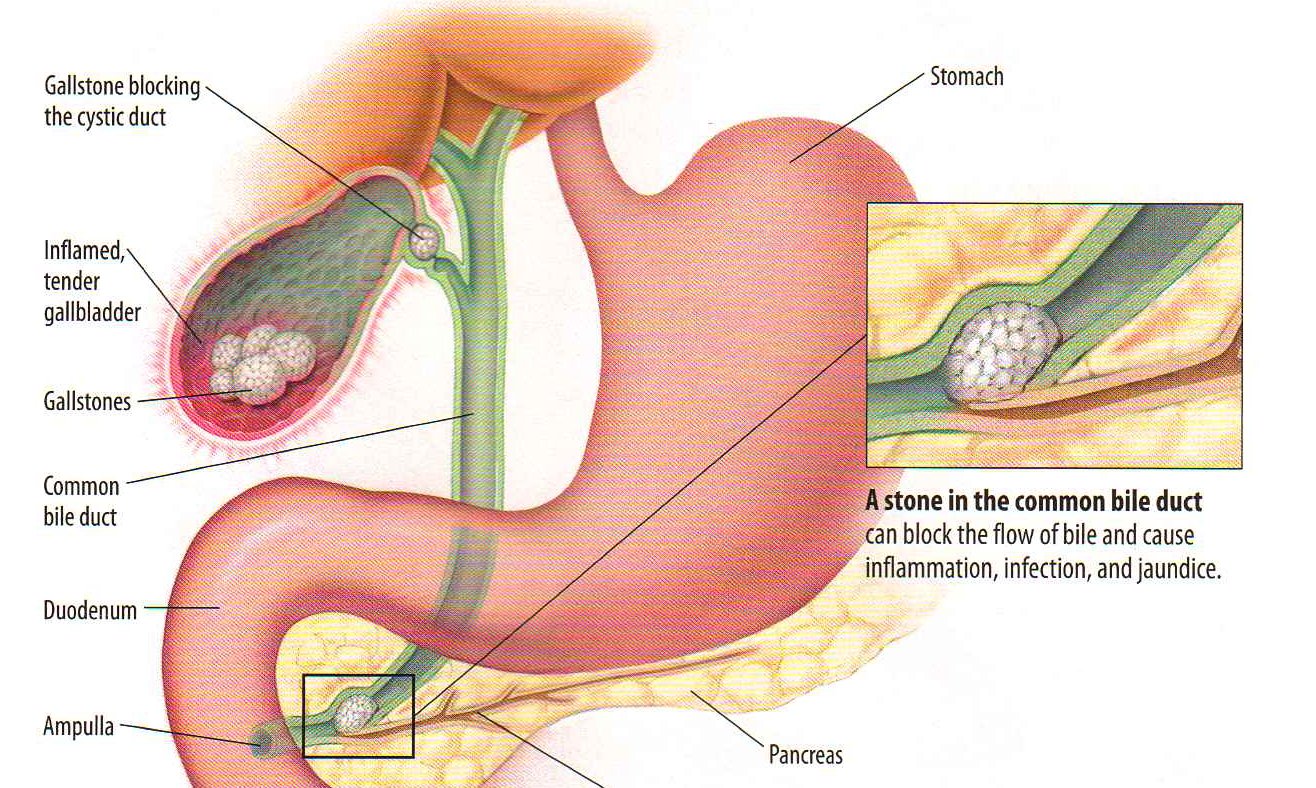
Under normal circumstances, the concentration of bile acids is sufficient to keep cholesterol in a liquid state. However, several factors can disrupt this delicate balance:
- High-fat diet: Excessive consumption of fatty foods can lead to increased cholesterol production by the liver, overwhelming the bile acids’ ability to keep it dissolved.
- Extremely low-fat diet: Paradoxically, a diet very low in fat can also contribute to gallstone formation. With less fatty food to digest, the gallbladder is used less frequently, allowing more time for cholesterol to solidify.
- Reduced gallbladder activity: Conditions that decrease gallbladder function, such as cirrhosis, pregnancy, or the use of certain medications, can increase the risk of gallstone formation.
Prevalence and Risk Factors for Gallstones
Gallstones affect approximately 30 million American adults, with about a million new cases diagnosed each year in the United States. While many individuals with gallstones are asymptomatic, understanding the risk factors can help in prevention and early detection.

Who is More Likely to Develop Gallstones?
Certain demographic groups and individuals with specific characteristics are at higher risk of developing gallstones:
- Women: They are twice as likely as men to develop gallstones.
- Older adults: People over 60 have an increased risk.
- Native Americans: This group has the highest rates of gallstones in the U.S., likely due to a genetic predisposition to secrete high levels of cholesterol in bile.
- Mexican-Americans: They also have higher rates of gallstones compared to the general population.
- Individuals with obesity or those who have experienced rapid weight loss.
- People with diabetes or sickle cell disease.
- Women who have had multiple pregnancies or use hormone replacement therapy or birth control pills.
Do genetic factors play a role in gallstone formation? Yes, family history can increase an individual’s risk of developing gallstones. This genetic predisposition, combined with environmental factors and lifestyle choices, contributes to the overall likelihood of gallstone development.
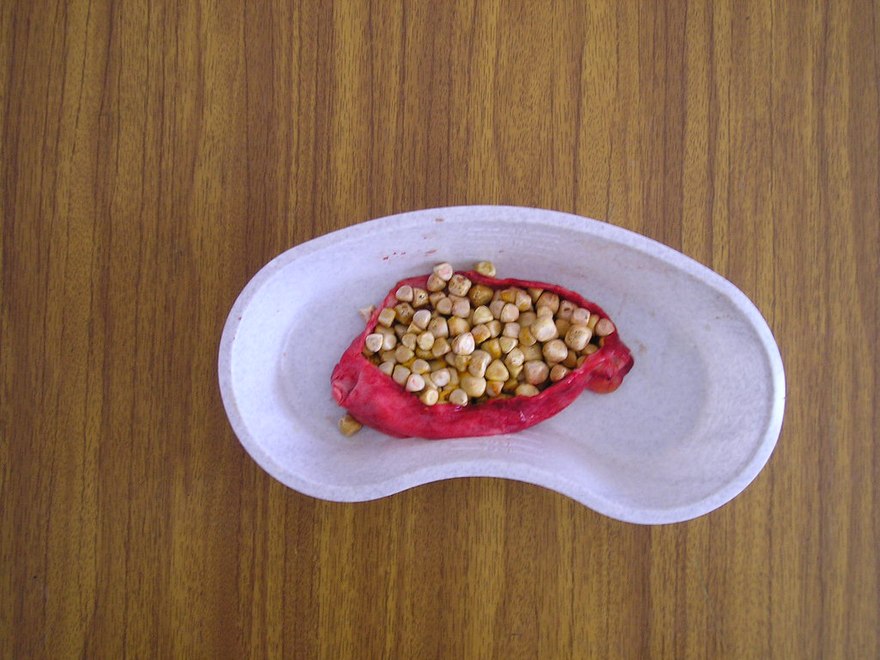
Recognizing the Symptoms of Gallstones
Many individuals with gallstones experience no symptoms, a condition known as “silent” gallstones. However, when symptoms do occur, they can be quite distinctive and often relate to the stone’s movement within the biliary system.
Common Symptoms of Gallstones
When gallstones become symptomatic, individuals may experience:
- Abdominal pain: Often occurring within an hour after eating a large meal or in the middle of the night.
- Nausea and indigestion
- Fever
- Jaundice: In cases where stones block the common bile duct
- Severe and frequent vomiting: In rare cases where gallstones migrate into the small intestine
Why do these symptoms occur? The pain and discomfort typically result from the gallbladder contracting against a lodged stone, causing obstruction in the bile ducts. This obstruction can lead to inflammation and potentially infection of the affected duct.
Complications Associated with Gallstones
While many gallstones remain asymptomatic, they can lead to serious complications if left untreated. Understanding these potential issues is crucial for timely intervention and prevention of more severe health problems.
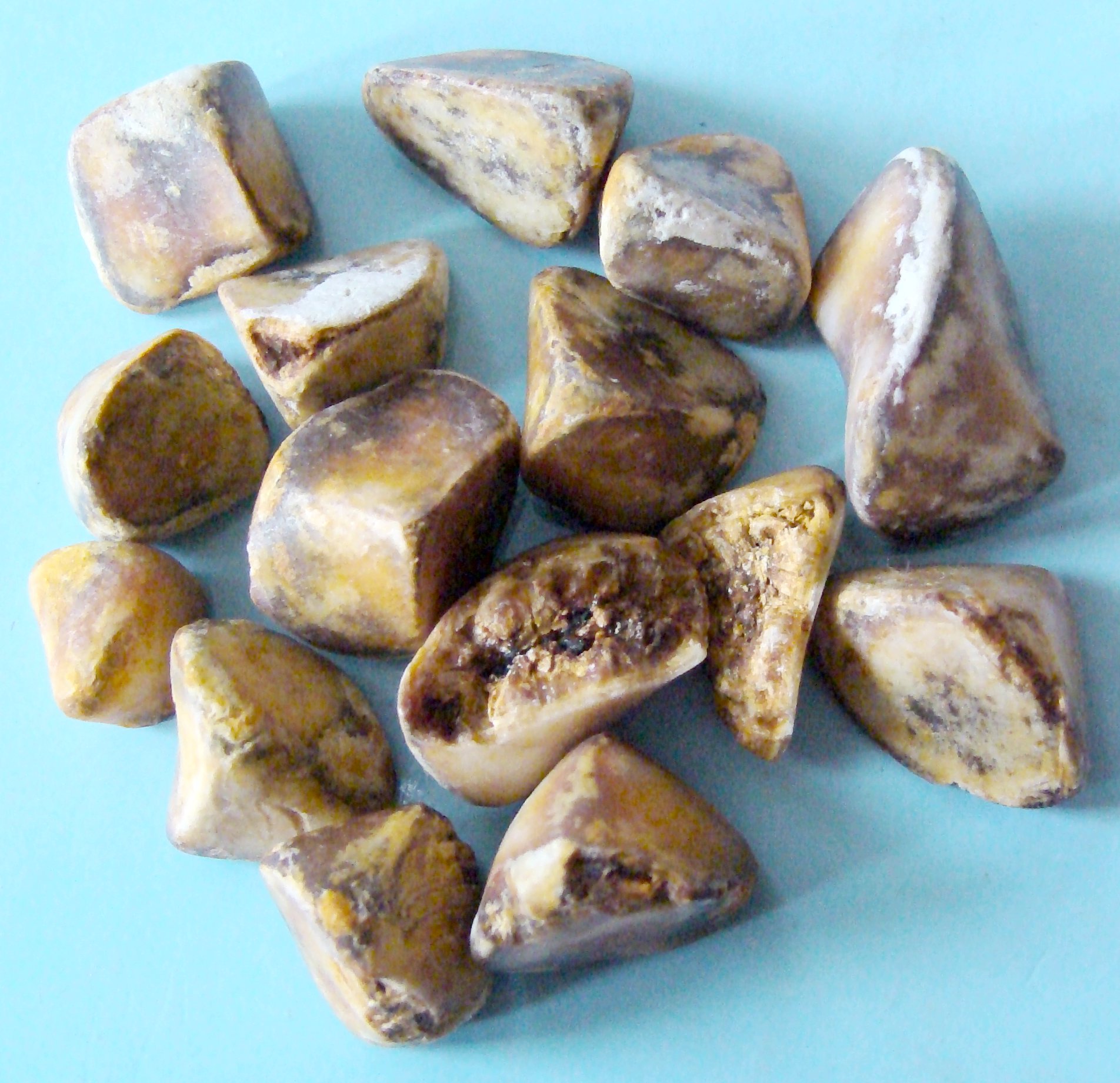
Potential Complications of Gallstones
- Cholecystitis: Inflammation of the gallbladder
- Choledocholithiasis: Blockage of the common bile duct
- Gallstone pancreatitis: Inflammation of the pancreas due to blockage of the pancreatic duct
- Cholangitis: Infection of the bile ducts
- Gallbladder cancer: While rare, large gallstones (over 3 cm in diameter) may increase the risk
How often do gallstones lead to complications? While most gallstones remain asymptomatic, individuals with silent gallstones have a 20% chance of experiencing an episode of pain during their lifetime. The longer a stone exists in the gallbladder, the more likely it is to become problematic.
Diagnosing Gallstones: Tests and Procedures
Accurate diagnosis of gallstones is essential for appropriate treatment. Healthcare providers use various diagnostic tools and procedures to detect and evaluate gallstones.
Common Diagnostic Methods for Gallstones
- Ultrasound: The most common and preferred method for detecting gallstones
- CT scan: Provides detailed images of the gallbladder and surrounding structures
- HIDA scan: Assesses gallbladder function and detects blockages in the bile ducts
- Blood tests: Can indicate inflammation or infection related to gallstones
- Endoscopic retrograde cholangiopancreatography (ERCP): Allows for both diagnosis and potential treatment of gallstones in the bile ducts
Why is ultrasound the preferred diagnostic method for gallstones? Ultrasound is non-invasive, doesn’t use radiation, and provides real-time images of the gallbladder. It can detect stones as small as 2 mm in diameter with high accuracy.
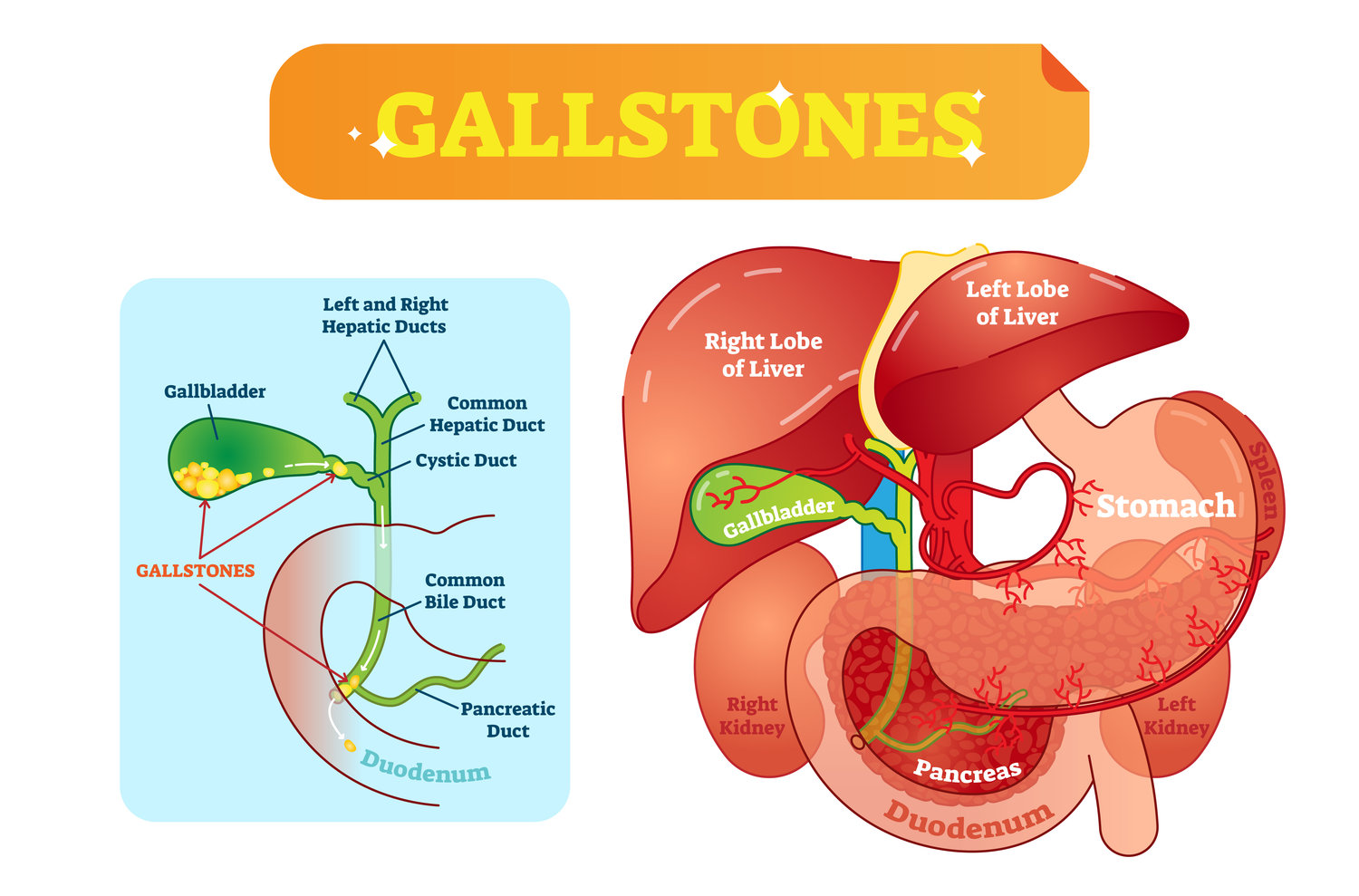
Conventional Treatment Options for Gallstones
The treatment approach for gallstones depends on the severity of symptoms and the presence of complications. Medical professionals consider various factors when recommending treatment options.
Medical Interventions for Gallstones
- Watchful waiting: For asymptomatic gallstones
- Cholecystectomy: Surgical removal of the gallbladder, often performed laparoscopically
- Oral dissolution therapy: Medication to dissolve small cholesterol stones
- Lithotripsy: Use of shock waves to break up gallstones (less common)
- ERCP: For removing stones from the bile ducts
Which treatment is most commonly recommended for symptomatic gallstones? Cholecystectomy, particularly laparoscopic cholecystectomy, is the most frequently recommended treatment for symptomatic gallstones. This procedure is considered the gold standard due to its effectiveness and relatively low risk of complications.
Natural Remedies and Lifestyle Changes for Gallstone Management
While medical treatments are often necessary for symptomatic gallstones, some individuals explore natural remedies and lifestyle changes to manage their condition or prevent stone formation.
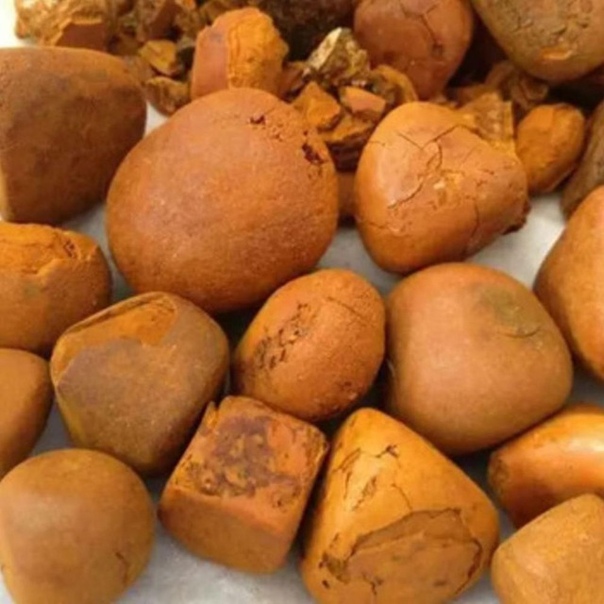
Potential Natural Approaches to Gallstone Management
- Dietary modifications: Reducing fat intake and increasing fiber consumption
- Weight management: Maintaining a healthy weight or losing weight gradually
- Exercise: Regular physical activity to promote overall health and potentially reduce gallstone risk
- Herbal remedies: Some people use herbs like milk thistle or peppermint, though scientific evidence is limited
- Gallbladder flush or cleanse: A controversial method involving drinking olive oil and fruit juice
Are natural remedies effective for treating gallstones? While some natural approaches may help prevent gallstone formation or manage mild symptoms, there is limited scientific evidence supporting their effectiveness in treating existing gallstones. It’s crucial to consult with a healthcare provider before attempting any natural remedies, especially for symptomatic gallstones.
The Gallbladder Cleanse: A Closer Look
The gallbladder cleanse, often touted as a natural remedy for gallstones, involves consuming large quantities of olive oil and fruit juice over several days. Proponents claim this method can flush out gallstones, but medical professionals are skeptical about its effectiveness and safety.

Why are medical professionals cautious about gallbladder cleanses? There is no scientific evidence supporting the effectiveness of gallbladder cleanses in removing or dissolving gallstones. Moreover, these cleanses can potentially cause side effects such as nausea, vomiting, and diarrhea. In some cases, they may even lead to complications if attempted in the presence of large gallstones or other gallbladder issues.
Prevention Strategies for Gallstones
While some risk factors for gallstones, such as age and genetics, cannot be modified, there are several strategies individuals can employ to reduce their risk of developing gallstones.
Lifestyle Modifications to Reduce Gallstone Risk
- Maintain a healthy weight: Avoid rapid weight loss or yo-yo dieting
- Eat a balanced diet: Include plenty of fruits, vegetables, whole grains, and lean proteins
- Stay hydrated: Drink adequate water throughout the day
- Exercise regularly: Aim for at least 150 minutes of moderate-intensity exercise per week
- Limit alcohol consumption: Excessive alcohol intake can increase the risk of gallstones
- Manage underlying health conditions: Control diabetes and other health issues that may contribute to gallstone formation
How effective are these prevention strategies? While no prevention method is foolproof, adopting these lifestyle modifications can significantly reduce the risk of gallstone formation. These strategies not only help prevent gallstones but also contribute to overall health and well-being.

In conclusion, understanding the formation, symptoms, and treatment options for gallstones is crucial for managing this common condition. While conventional medical treatments remain the most reliable approach for symptomatic gallstones, lifestyle modifications and preventive measures play a vital role in reducing the risk of gallstone formation. As research continues, new insights into gallstone prevention and management may emerge, offering hope for improved outcomes for those affected by this condition.
Gallstones Picture, Causes, Age, & Symptoms
Written by WebMD Editorial Contributors
- What Causes Gallstones?
Gallstones are crystal-like deposits that develop in the gallbladder — a small, pear-shaped organ that stores bile, a digestive fluid produced by the liver.
These deposits may be as small as a grain of sand or as large as a golf ball; they may be hard or soft, smooth or jagged. You may have several gallstones or just one.
Some 30 million American adults suffer from gallstones. Yet most of those who have the condition do not realize it. In this case, what you don’t know probably won’t hurt you; gallstones that are simply floating around inside the gallbladder generally cause no symptoms and no harm.
These “silent” stones usually go unnoticed unless they show up in an ultrasound exam conducted for some other reason. However, the longer a stone exists in the gallbladder, the more likely it is to become problematic. People who have gallstones without symptoms have 20% chance of having an episode of pain during their lifetime.
When symptoms do occur, it’s usually because the gallstone has moved and become lodged within a duct that carries bile, such as the cystic duct, a small conduit that connects the gallbladder to another tube called the common bile duct. The typical symptom is abdominal pain, perhaps accompanied by nausea, indigestion, or fever. The pain, caused by the gallbladder’s contraction against the lodged stone, generally occurs within an hour of eating a large meal or in the middle of the night. Stones can also clog the common bile duct, which carries bile into the small intestine, and the hepatic ducts, which take bile out of the liver.
Obstructions in the bile pathway may cause a duct to become inflamed and possibly infected. Blockage of the common bile duct, which merges with the pancreatic duct at the small intestine, can also lead to inflammation of the pancreas (gallstone pancreatitis).
In a rare but dangerous condition that occurs most often in older women, gallstones migrate into the small intestine and block the passageway into the large intestine; symptoms include severe and frequent vomiting.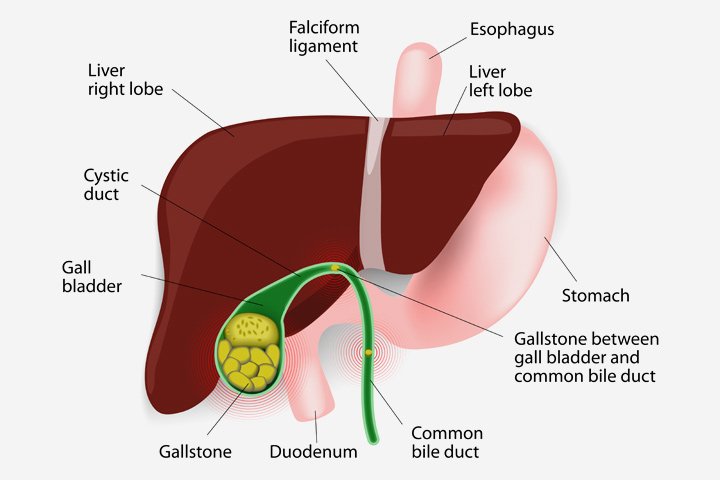 Although gallstones are present in about 80% of people with gallbladder cancer, it is uncertain whether gallstones play a role, except when really large stones (greater than 3 centimeters in diameter) are present.
Although gallstones are present in about 80% of people with gallbladder cancer, it is uncertain whether gallstones play a role, except when really large stones (greater than 3 centimeters in diameter) are present.
About a million new cases of gallstones are diagnosed in the U.S. each year. For reasons that are still unclear, women are two times more likely than men to be afflicted. Native Americans have the highest rates of gallstones in the U.S. because they have a genetic disposition to secrete high levels of cholesterol in bile (a contributing factor to gallstones.) Mexican-Americans also have high rates of gallstones.
Gallstones are also more common in people over age 60, in those who are obese or have lost a lot of weight in a short amount of time, in those who have diabetes or sickle cell disease, and in women who have had multiple pregnancies and who take hormone replacement therapy or birth control pills.
The primary function of the gallbladder is to store bile, a brown or yellowish fluid that helps the body break down fatty food. When you eat a meal, the gallbladder releases its stored bile into the cystic duct. From there the fluid passes through the common bile duct and into the small intestine to mix with food.
When you eat a meal, the gallbladder releases its stored bile into the cystic duct. From there the fluid passes through the common bile duct and into the small intestine to mix with food.
Chief among the ingredients of bile are cholesterol and bile acids. Normally, the concentration of bile acids is high enough to break down the cholesterol in the mixture and keep it in liquid form. However, a diet high in fat can tip this delicate balance, causing the liver to produce more cholesterol than the bile acids are able to handle. As a result, some of this excess cholesterol begins to solidify into crystals, which we call gallstones. About 80% of all gallstones are called cholesterol stones and are created this way. The remaining 20% consist of calcium mixed with the bile pigment bilirubin and are called pigment stones. Sickle cell and other blood disorders where red blood cells are destroyed can often lead to pigment gallstones
Gallstones can form even in people who eat properly. And as researchers have found, a diet extremely low in fat can also contribute to gallstone formation: With little fatty food to digest, the gallbladder is called into play less frequently than usual, so the cholesterol has more time to solidify. Other factors that can reduce activity in the gallbladder, possibly leading to gallstone formation, include cirrhosis, the use of birth control pills or hormone replacement therapy, and pregnancy.
And as researchers have found, a diet extremely low in fat can also contribute to gallstone formation: With little fatty food to digest, the gallbladder is called into play less frequently than usual, so the cholesterol has more time to solidify. Other factors that can reduce activity in the gallbladder, possibly leading to gallstone formation, include cirrhosis, the use of birth control pills or hormone replacement therapy, and pregnancy.
Family history, diabetes, sudden weight loss, and cholesterol drugs, and older age can also increase risk for gallstones.
Top Picks
Gallstones Diagnosis, Tests, & Treatments
Written by WebMD Editorial Contributors
- How Do I Know if I Have Gallstones?
- What Are the Treatments for Gallstones?
- Conventional Medicine for Gallstones
- Gallstones and Watchful Waiting
- Nonsurgical Therapy for Gallstones
- Surgery to Remove the Gallbladder
- More
If your symptoms suggest a gallstone problem, your doctor might first examine your skin for jaundice, and then feel your abdomen to check for tenderness. A blood test may reveal evidence of an obstruction.
A blood test may reveal evidence of an obstruction.
Because other digestive problems, such as an infection of the duct, can produce symptoms similar to those of a gallstone attack, the doctor may also run other tests to determine if gallstones are in fact the culprit.
The most common technique is an ultrasound exam. This quick, painless procedure uses high-frequency sound waves to create pictures of the gallbladder, bile duct, and their contents. CT scans are also sometimes done to look at the anatomy of your internal organs.
A more complicated test may be used if the doctor suspects that a gallstone is lodged in a bile duct. Commonly known by the acronym ERCP, this test allows the doctor to look at the bile duct through a small flexible tube called an endoscope. The doctor sprays the back of the patient’s throat with an anesthetic drug to prevent gagging, sedates the patient, and passes the endoscope into the mouth, through the stomach, and into the area of the small intestine where the bile duct enters. Dye is injected through the tube and into the bile duct, and then the doctor takes X-rays. Stone removal can be done during this procedure as well. The procedure takes about an hour.
Dye is injected through the tube and into the bile duct, and then the doctor takes X-rays. Stone removal can be done during this procedure as well. The procedure takes about an hour.
In most cases, treatment of gallstones is considered necessary only if you are having symptoms. Of the various conventional treatments that are available, surgical removal of the gallbladder is the most widely used. Some alternative treatments have also been found to be effective in alleviating the symptoms of troublesome gallstones.
When deciding what course of action to take for symptomatic gallstones, doctors usually choose from among three main treatment options: Watchful waiting, nonsurgical therapy, and surgical removal of the gallbladder.
Though a gallstone episode can be extremely painful or frightening, almost a third to half of all people who experience an attack never have a recurrence. In some cases, the stone dissolves or becomes dislodged and thereby resumes its “silence.” Because the problem may solve itself without intervention, many doctors take a wait-and-see approach following the initial episode.
Even when the patient has had repeated gallstone episodes, the doctor may postpone treatment or surgery because of other health concerns. If your surgery has been delayed, you should remain under a doctor’s care and report any recurrences of gallstone symptoms immediately.
If you are unable or unwilling to go through surgery for a gallstone problem that requires treatment, your doctor may recommend one of several noninvasive techniques. Note that though these methods may destroy symptom-causing gallstones, they can do nothing to prevent others from forming, and recurrence is common.
Some gallstones can be dissolved through the use of a bile salt, although the procedure can be used only with stones formed from cholesterol and not from bile pigments. The drug Actigall (ursodiol) is taken as a tablet; depending on its size, the gallstone may take months or even years to go away. Because some stones are calcified, this treatment often doesn’t work.
Another nonsurgical technique, shock wave therapy, uses high-frequency sound waves to fragment the stones. Bile salt is administered afterward to dissolve small pieces. This therapy is rarely used.
Bile salt is administered afterward to dissolve small pieces. This therapy is rarely used.
Doctors can also attempt to remove gallstones during an ERCP. During the procedure an instrument is inserted through the endoscope to attempt removal of the stone.
While these therapies may work for some, all of the above nonsurgical therapies are usually unsuccessful long term (since recurrence is common) and are rarely advised in clinical practice.
While the gallbladder serves an important function, it is not essential for a normal, healthy life. When gallstones are persistently troublesome, doctors often recommend removing the organ entirely. This operation is considered among the safest of all surgical procedures. Each year approximately 750,000 Americans have their gallbladder removed. It is also the only treatment method that eliminates the possibility that other gallstones will develop in the future.
When the gallbladder has been removed, bile flows directly from the liver into the small intestine, and this sometimes leads to diarrhea. Because bile no longer accumulates in the gallbladder, quantities of the digestive fluid cannot be stored up and used to break down an especially fatty meal. This condition is not considered serious, however, and can be corrected by simply limiting fat in the diet.
Because bile no longer accumulates in the gallbladder, quantities of the digestive fluid cannot be stored up and used to break down an especially fatty meal. This condition is not considered serious, however, and can be corrected by simply limiting fat in the diet.
In the past, removal of the gallbladder was done through traditional “open” surgery, which requires surgeons to make a large incision in the abdomen. Patients faced a two- or three-day hospital stay plus several weeks of recovery at home.
Today, however, the most commonly used surgical technique is a much simpler approach known as laparoscopic cholecystectomy. The doctor makes several small incisions in the abdomen, then uses special pencil-thin instruments to remove the gallbladder. A tiny microscope and video camera, snaked through the incision to the site, allow the surgeon to view the operation.
Laparoscopic surgery is highly effective and very safe. It has reduced the hospital stay to a day or two. Patients report less pain and are generally able to resume a normal lifestyle in a short period of time. However, people who are obese or who have a severe infection or inflammation in the gallbladder may still be considered candidates for traditional open surgery.
However, people who are obese or who have a severe infection or inflammation in the gallbladder may still be considered candidates for traditional open surgery.
Top Picks
symptoms and when to see a doctor
Gallstone disease (GSD) is the formation of stones (calculi) in the gallbladder and bile ducts. Gallstones are hardened deposits of digestive fluid that most commonly form in your gallbladder. Your gallbladder is a small, pear-shaped organ on the right side of your abdomen, just below your liver. The gallbladder contains a digestive fluid called bile, which is secreted into the small intestine to aid in the digestion of food.
The gallbladder contains a digestive fluid called bile, which is secreted into the small intestine to aid in the digestion of food.
Gallbladder stones range in size from a grain of sand to a golf ball. Some people develop only one gallstone, while others develop many small stones at the same time.
The presence of stones carries the risk of developing dangerous conditions and severe complications.
Symptoms
Gallstones often cause no signs or symptoms. If a gallstone gets stuck in the duct and causes a blockage, the following symptoms develop:
- Sudden and rapidly increasing pain in the center of the abdomen, just below the sternum, on the right
- Pain in the back between the shoulder blades
- Right shoulder pain
- Nausea or vomiting
- Pain associated with gallstone disease can last from several minutes to several hours
When to see a doctor
Make an appointment with your doctor if you have any signs or symptoms that worry you.
Read about the diagnosis and treatment of cholelithiasis at the link.
Seek care right away if you develop signs and symptoms of a serious complication associated with gallstones, for example:
- Abdominal pain so severe that you cannot sit still or find a comfortable position
- Yellowing of the skin and whites of the eyes (jaundice)
- High fever with chills
Number for calling an ambulance in Moscow – 103
Causes of cholelithiasis
It is unclear what causes gallstones. Doctors believe that gallstones can occur in the following cases:
Your bile contains too much cholesterol . Normally, your bile contains enough chemicals to dissolve the cholesterol secreted by your liver. But if your liver secretes more cholesterol than bile can dissolve, the excess cholesterol can turn into crystals and eventually stones.
Your bile contains too much bilirubin . Bilirubin is a chemical produced when red blood cells are broken down in the body. Under certain conditions, the liver produces too much bilirubin, including cirrhosis of the liver, biliary tract infections, and certain blood disorders. Excess bilirubin contributes to the formation of gallstones.
Bilirubin is a chemical produced when red blood cells are broken down in the body. Under certain conditions, the liver produces too much bilirubin, including cirrhosis of the liver, biliary tract infections, and certain blood disorders. Excess bilirubin contributes to the formation of gallstones.
Your gallbladder is not emptying properly. If the gallbladder does not empty completely or often enough, the bile can become very concentrated, which promotes the formation of gallstones.
Types of gallstones
Types of gallstones that can form in the gallbladder include:
Cholesterol stones in the gallbladder. The most common type of gallstones, called cholesterol gallstones, are often yellow in color. These gallstones are made up primarily of undissolved cholesterol, but may contain other components.
Pigment stones in the gallbladder. These dark brown or black stones form when your bile contains too much bilirubin.
Risk factors
Factors that may increase the risk of gallstones include:
- Female sex
- Age 40 and over
- Overweight or obese
- Sedentary
- Pregnancy
- High fat diet
- High cholesterol diet
- Low fiber diet
- Family history of gallstones
- Diabetes
- Presence of certain blood disorders such as sickle cell anemia or leukemia
- Very fast weight loss
- Taking medications containing estrogen, such as oral contraceptives or hormone therapy drugs.
- Liver disease
Complications
Complications of gallstones may include:
Inflammation of the gallbladder . A gallstone lodged in the neck of the gallbladder can cause inflammation of the gallbladder (cholecystitis). Cholecystitis can cause severe pain, peritonitis.
Blockage of the common bile duct . Gallstones can block the channels (ducts) that carry bile from the gallbladder or liver to the small intestine.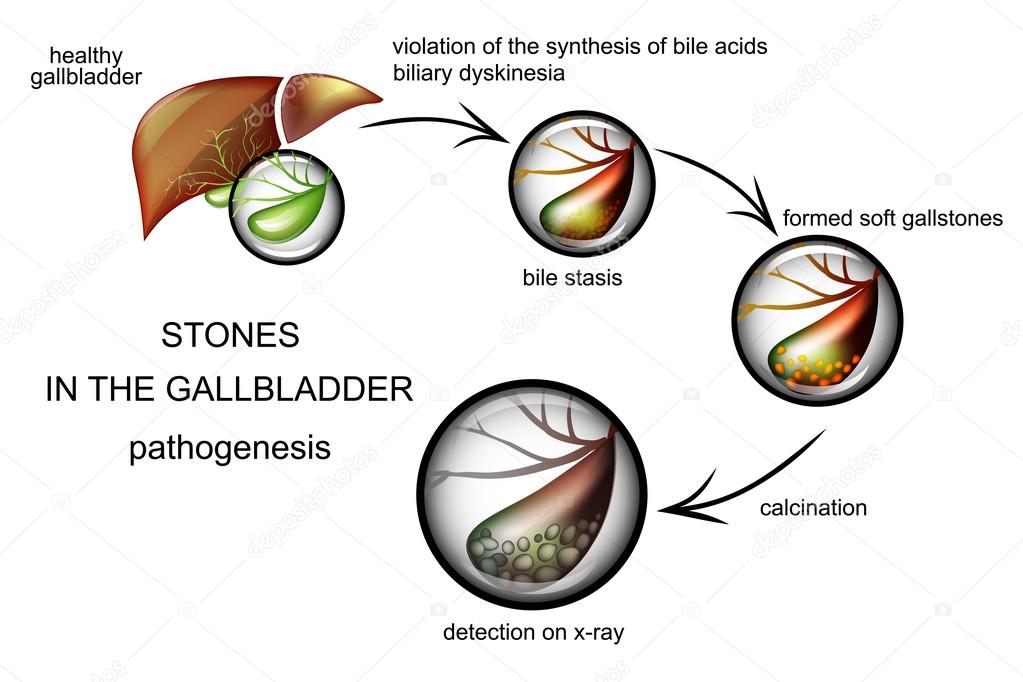 This can lead to severe pain, jaundice, and bile duct infection.
This can lead to severe pain, jaundice, and bile duct infection.
Obstruction of the pancreatic duct . The pancreatic duct is a tube from the pancreas and joins the common bile duct just before entering the duodenum. The pancreatic juices that aid digestion pass through the pancreatic duct.
A gallstone can cause blockage of the pancreatic duct, which can lead to inflammation of the pancreas (pancreatitis). Pancreatitis causes severe, persistent abdominal pain and usually requires hospitalization. Severe forms of pancreatitis often end in the death of the patient.
Gall bladder cancer . People with gallstones have an increased risk of developing gallbladder cancer.
Prevention of gallstones
You can reduce the risk of gallstones:
Do not skip meals . Try to stick to your regular meal times every day. Skipping meals or fasting can increase your risk of gallstones.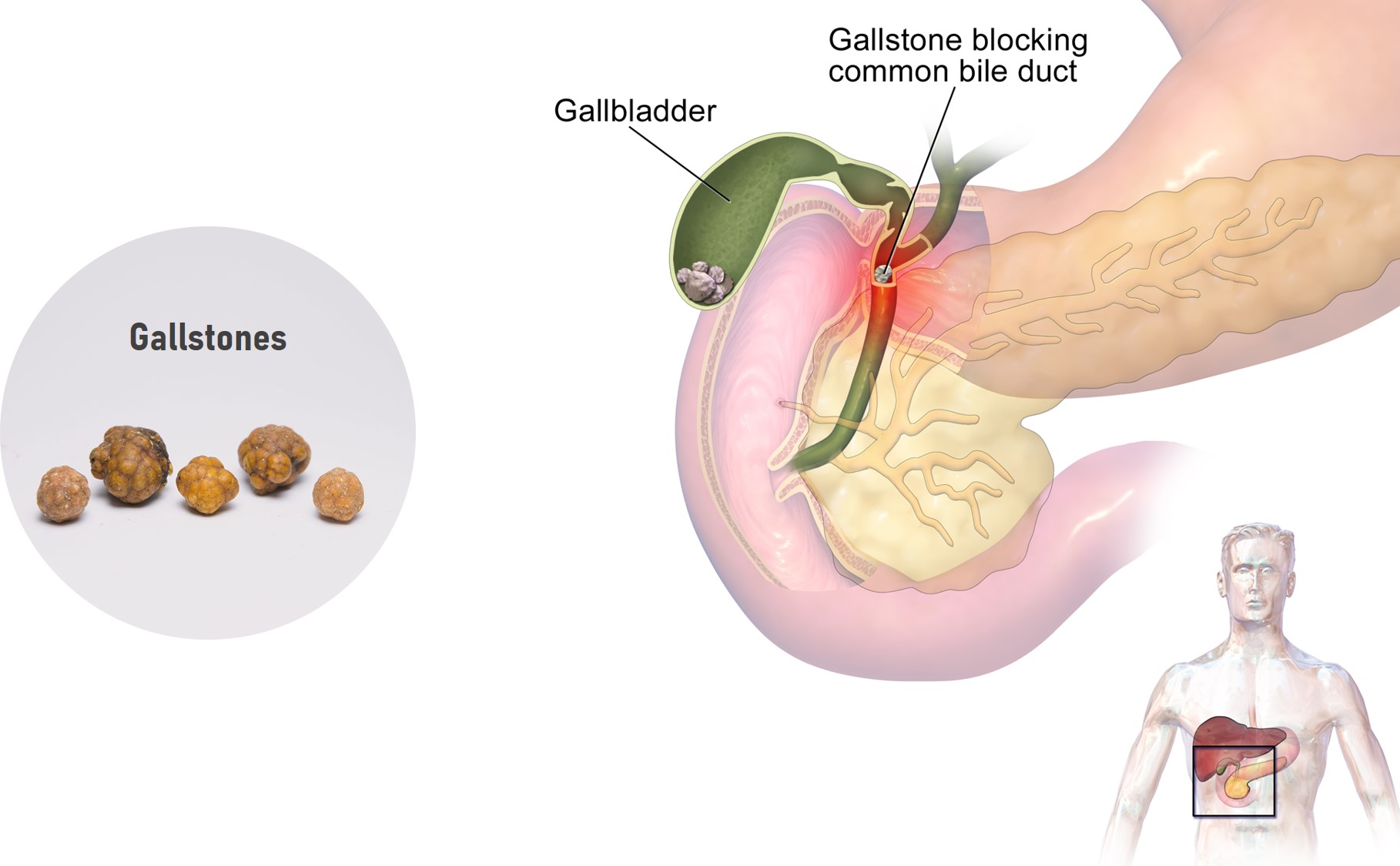
Lose weight slowly . If you need to lose weight, take your time. Rapid weight loss can increase the risk of gallstones.
Eat more high fiber foods . Include more fiber-rich foods in your diet, such as fruits, vegetables, and whole grains.
Maintain a healthy weight . Obesity and overweight increase the risk of gallstones. Work towards a healthy weight by cutting calories and increasing physical activity. Once you reach a healthy weight, work on maintaining it by continuing to eat a healthy diet and keep exercising.
Stones in the gallbladder – is it necessary to operate?
home
/
About Us
/
Helpful information
/
Stones in the gallbladder – is it necessary to operate?
11/28/2018
The formation of stones in the gallbladder is the main symptom of gallstone disease (GSD).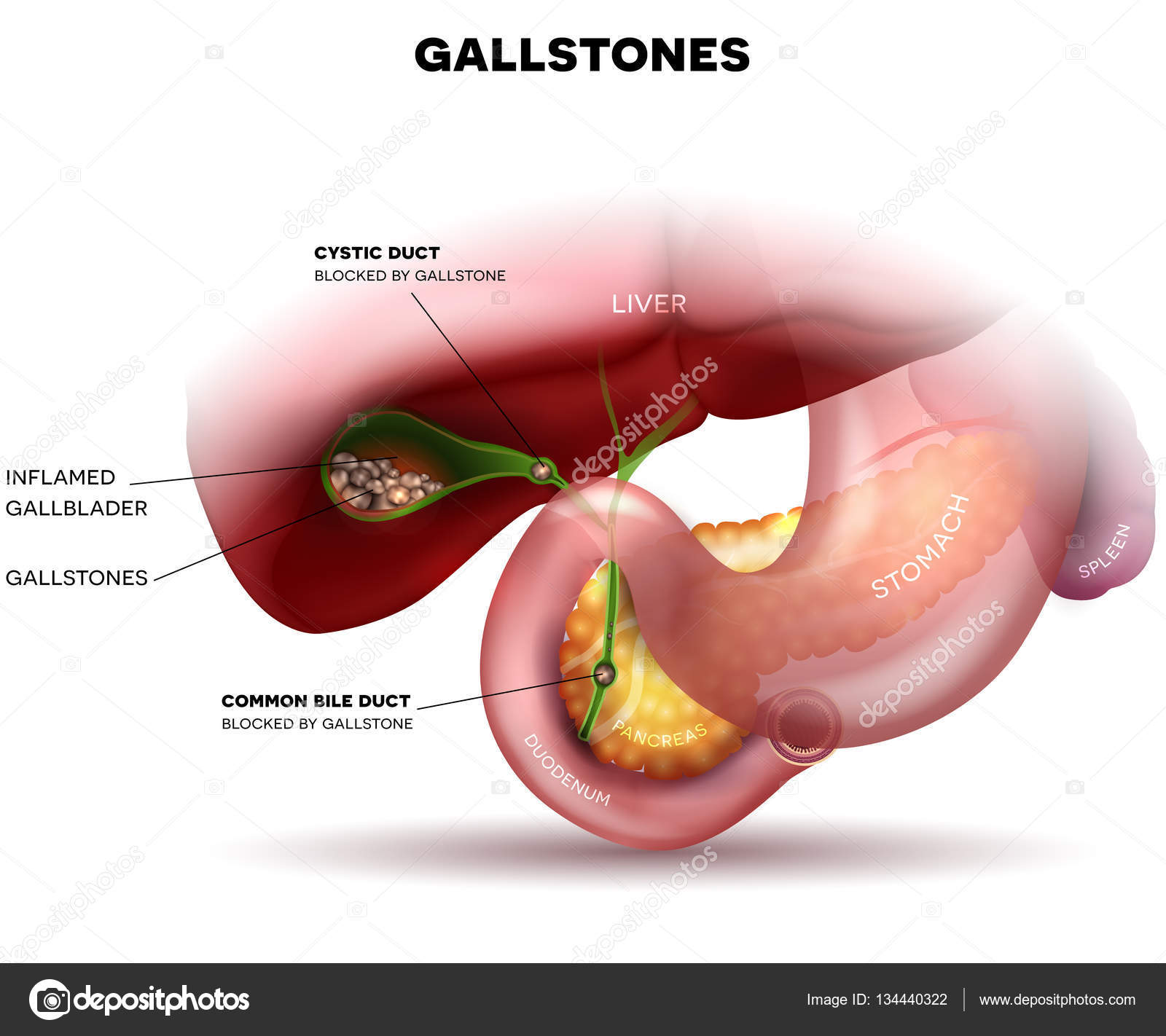 In Russia and Europe, this disease is registered in 10-15% of the population. The source of the development of stones are cholesterol, salts and other components of bile, which is formed in the liver and then accumulates in the gallbladder. The formation of gallstones is promoted by stagnation of bile, inflammation in the wall of the gallbladder and ducts, hormonal and metabolic disorders. Sometimes gallstones may not manifest themselves, but most often they cause pain and other concerns. The greatest danger is the complications of gallstone disease.
In Russia and Europe, this disease is registered in 10-15% of the population. The source of the development of stones are cholesterol, salts and other components of bile, which is formed in the liver and then accumulates in the gallbladder. The formation of gallstones is promoted by stagnation of bile, inflammation in the wall of the gallbladder and ducts, hormonal and metabolic disorders. Sometimes gallstones may not manifest themselves, but most often they cause pain and other concerns. The greatest danger is the complications of gallstone disease.
Why is cholelithiasis dangerous?
– The presence of stones in the gallbladder constantly maintains inflammation in its wall. In the presence of provoking factors – the intake of fatty foods, alcohol, physical activity – the inflammation worsens, and an attack of acute cholecystitis develops, which may require emergency surgery. It is impossible to completely cure chronic cholecystitis in the presence of gallstones.
– The contraction of the gallbladder after a meal can lead to wedging of the stone into the excretory duct of the bladder, as a result of which the gallbladder becomes clogged and creates the effect of a “disabled gallbladder”.
– Small stones can pass from the gallbladder into the bile ducts, causing jaundice and acute pancreatitis. These diseases require emergency surgical treatment and so far often lead to death.
– Large stones can cause bedsores in the wall of the gallbladder. In this case, a fistula usually develops between the gallbladder and the intestines. The constant reflux of intestinal contents into the gallbladder and bile ducts leads to the development of severe inflammation in them.
– With a long course of calculous cholecystitis, chronic pancreatitis inevitably develops. In this case, even the elimination of cholecystitis (removal of the gallbladder) does not give a complete recovery, since pancreatitis continues to cause pain and other complaints.
– Prolonged trauma to the wall of the gallbladder stones in it can lead to the development of gallbladder cancer.
Ways to treat cholelithiasis?
The main treatment for gallstone disease is surgery. Methods of dissolution and crushing of gallstones have not justified themselves due to low efficiency, a large number of complications and high cost of treatment.
For more than 100 years, the main operation used for cholelithiasis has been cholecystectomy – the removal of the gallbladder. It does not make sense to remove the stones alone, since the cause of the disease is that the diseased gallbladder forms stones, and it is not the stones that cause gallbladder disease.
Previously, the gallbladder was removed through a large incision in the abdominal wall. Now the “gold standard” in the treatment of cholelithiasis is laparoscopic cholecystectomy, performed through small punctures. The operation takes about an hour. Postoperative hospital stay – 1-2 days. After the operation, it is recommended to limit excessive physical activity and follow a diet for 1-2 months.
Postoperative hospital stay – 1-2 days. After the operation, it is recommended to limit excessive physical activity and follow a diet for 1-2 months.
Today, laparoscopic cholecystectomy is a fairly safe operation. The complication rate does not exceed 0.1-0.3%, which is lower than in open operations.
What to do if cholelithiasis is detected?
Don’t expect complications! The first step on the road to recovery is to call us and come for a consultation with a surgeon. The specialist of our multidisciplinary clinic will determine the need for surgical treatment and answer all your questions.
To date, only one list of life-threatening complications of cholelithiasis dictates the need for urgent treatment of this disease. It should be recognized as hopelessly outdated recommendations “do not remove stones if they do not bother.”
Learn more about the possibilities of the Center for Minimally Invasive Surgery of the Reaviz multidisciplinary clinic.
Back to Articles
Do you want to be aware of promotions and events in Reaviz clinics?
Subscribe to the Newsletter and be the first to know about discounts on medical services, free events and profitable medical programs!
I consent to the processing of personal data, I agree to receive newsletters from Reaviz Medical Clinics and agree to the privacy policy
Thank you for subscribing! An email has been sent to your email to confirm your subscription.
Multidisciplinary clinic REAVIZ
Samara, st. Soviet Army, 243
Show on the map
DENTAL CLINIC REAVIZ
Samara, st. G. Dimitrova, 75
Show on the map
DEPARTMENT OF MEDICAL EXAMINATIONS
Samara, st. 22 party congress, 43, block No. 1,2,3, lit. A. 1st floor
Show on the map
EMERGENCY ROOM
Samara, st. Soviet Army, 243
Show on the map
PHARMACY ON BUBNOVA
Samara, st. Bubnova, 4
Show on the map
PHARMACY IN THE SOVIET ARMY
Samara, st.
